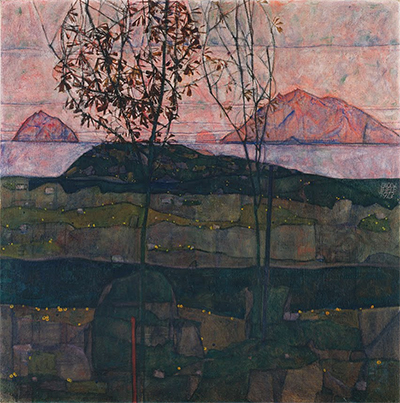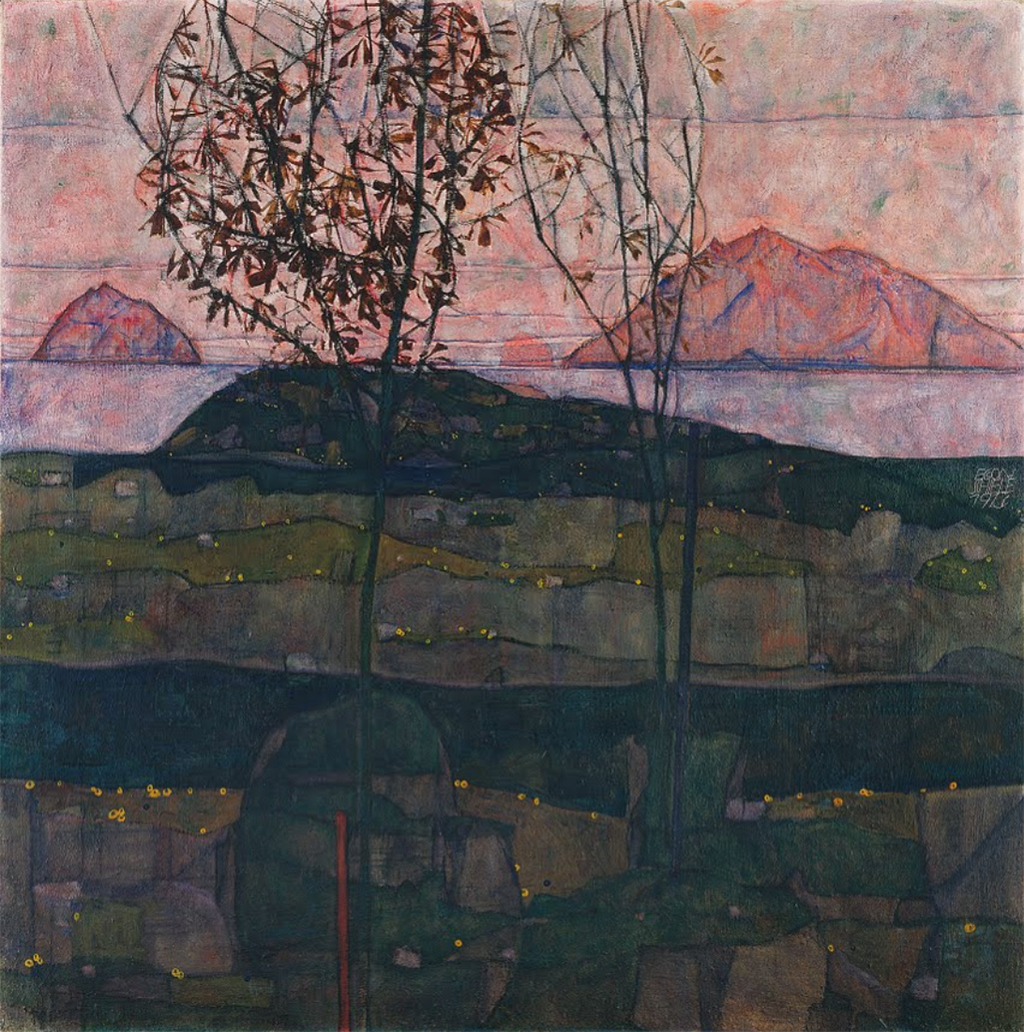Setting Sun is an Egon Schiele landscape painting from 1913 which can now be found in the Leopold Museum in Vienna, Austria. It remains one of his most highly regarded works within this genre.
Sinking Sun, as Schiele had originally titled this artwork features a melacholic expression through nature. In a similar way to Four Trees, there are elements of trees here which are drab and unhealthy. Versinkende Sonne (Sinking Sun) produces a cold feeling as light disapates. Light and colour were naturally key to expressionist artists, as shown with other paintings such as The Scream by Edvard Munch. The setting sun here illustrates how Schiele could use landscapes as well as portraits for communicating his emotions and the style of expressionism goes well beyond just recreating what one can see. We can see a real similarity between this painting and the work of Norwegian artist Munch, who would often create expressive and emotional recreations of the environment around him, such as with Shore with Red House and Summer in Aasgaardstrand.
There is a larger image of this painting featured below which is helpful in spotting some of the detail added by Schiele. With the bottom half of the composition being draped in darkness, it would otherwise be hard to decipher the different elements of that part of the composition. In the foreground we find two chestnut trees, infants perhaps only just planted, with a small number of leaves appearing on each. The scene is cropped aggressively leaving the absolute top and bottom of the two trees left out. This style of layout was perhaps inspired by Japanese print design, but also later became common within photography. Though youthful, the lack of greenery upon the trees suggests a lack of health, particularly as this part of the painting is dark and moody. In the far distance, however, are two small islands and perhaps a small mound inbetween which are themselves draped in sunlight, with tones of pink and red helping to create this atmosphere aroudn the setting sun. A close examination of the artwork reveals in the foreground there are a number of different tones of green, alternating in a subtle manner which builds up layers of darkened greenery. The sky, sea and islands opposite then contrast markedly, with an entirely alternative palette for that part of the work.
In the full breadth of art history trees have been used as vertical constructs within compositions, as a means of providing relative sizing or perspective. One can see this in a whole series of Pieter Bruegel drawings, for example, though that famous artist would actually sometimes place them to the far left or right of a scene in order to frame the rest of the content that lies besides it. Perspective was, of course, something that developed over time within art and made particular developments within the Italian Renaissance, as the flat artworks of the Middle Ages were replaced by experimental angles, sometimes inspired by architectural design. Andrea Mantegna paintings provide some examples of this, and the likes of Schiele would arrive many centuries later and take advantage of these earlier advancements, just as they would with other genres and disciplines such as landscape painting and portraiture. That said, the palettes of Schiele were entirely modern and remind us much more of the likes of Munch, as mentioned earlier, but also other expressionists such as Kirchner and Marc. Schiele himself arrived earlier, and so was very much at the forefront of these new ideas, underlining his creativity and also the significance of his career.
Setting Sun, or Versinkende Sonne to give it its original German title, can now be found in the collection of the Leopold Museum in Vienna, Austria. They have a wide selection of items from his career, including oil paintings, watercolours and also a number of letters and other notes from his lifetime. There are also a number of other venues within Vienna that also offers some items from Schiele's career, meaning it is a must-visit spot for those looking to see and enjoy as much of the artist's career as possible. Within the Leopold, along with Setting Sun, you may also wish to check out the likes of Seated Male Nude (Self Portrait), Portrait of Wally Neuzil, Self Portrait with Chinese Lantern Plant and also Moa. They also feature related artworks from other Austrian artists as well, helping to broaden the display and encourage people to return regularly as more items are added.
"...I mainly observe the physical movement of mountains, water, trees, and flowers now. Everywhere one is reminded of similar motions inside the human body, similar stirrings of pleasure and pain in plants. Painting alone is not enough for me; I know that one can use colors to establish qualities. When one sees an autumnal tree in summer, it is an intense experience that involves one's whole heart and being; and I should like to paint that melancholy."
Egon Schiele
"...You call this painting just a sunset.... Looking at this work, however, one would have to say, with all the appropriate melancholy, that the sun is sinking. It's already grown dark and cold in the foreground, and every leaf on the twigs has grown stiff from the cold. And before such a deeply melancholic sky, which no artist before Schiele ever painted in such a way, I am even moved to ask - will this sun, which is just departing, ever return?"
Rudolf Leopold





